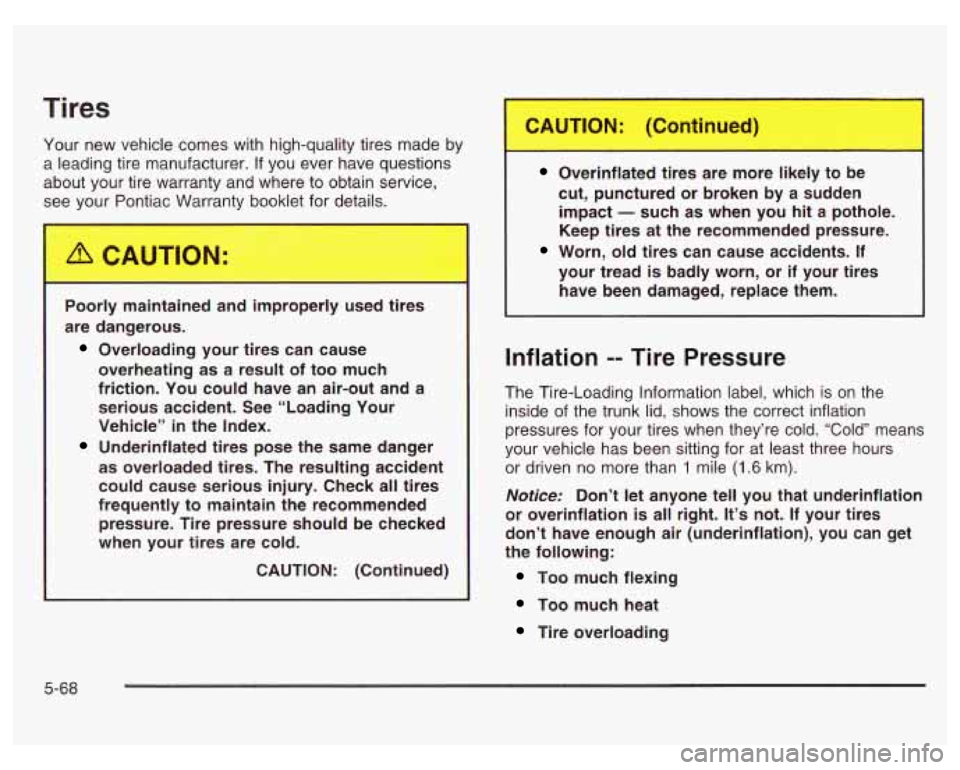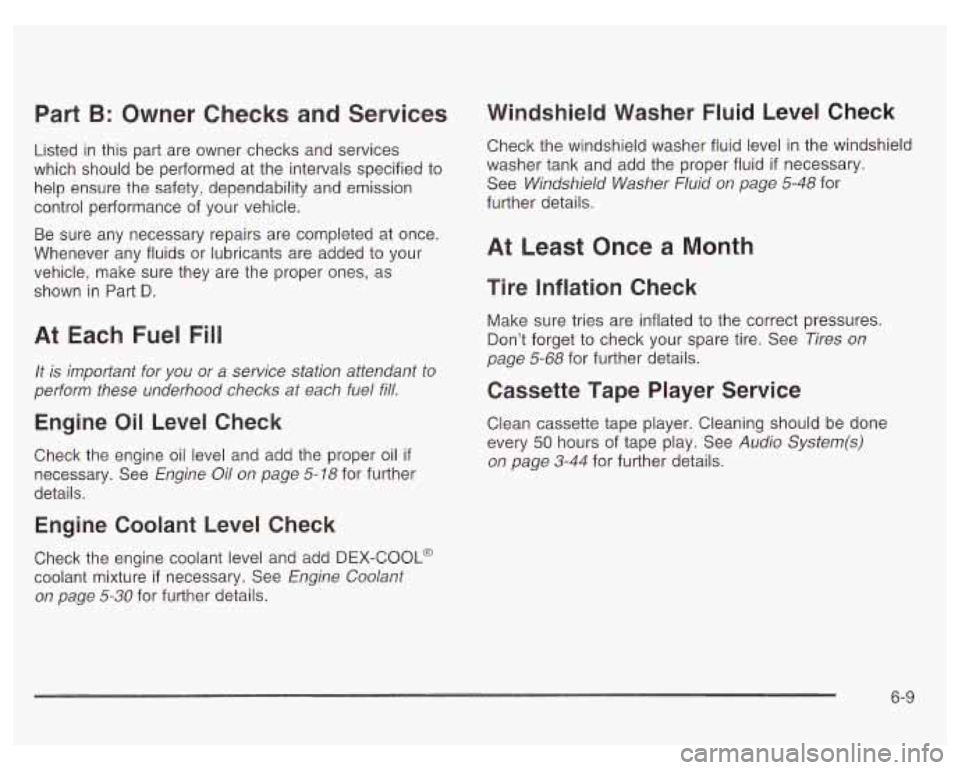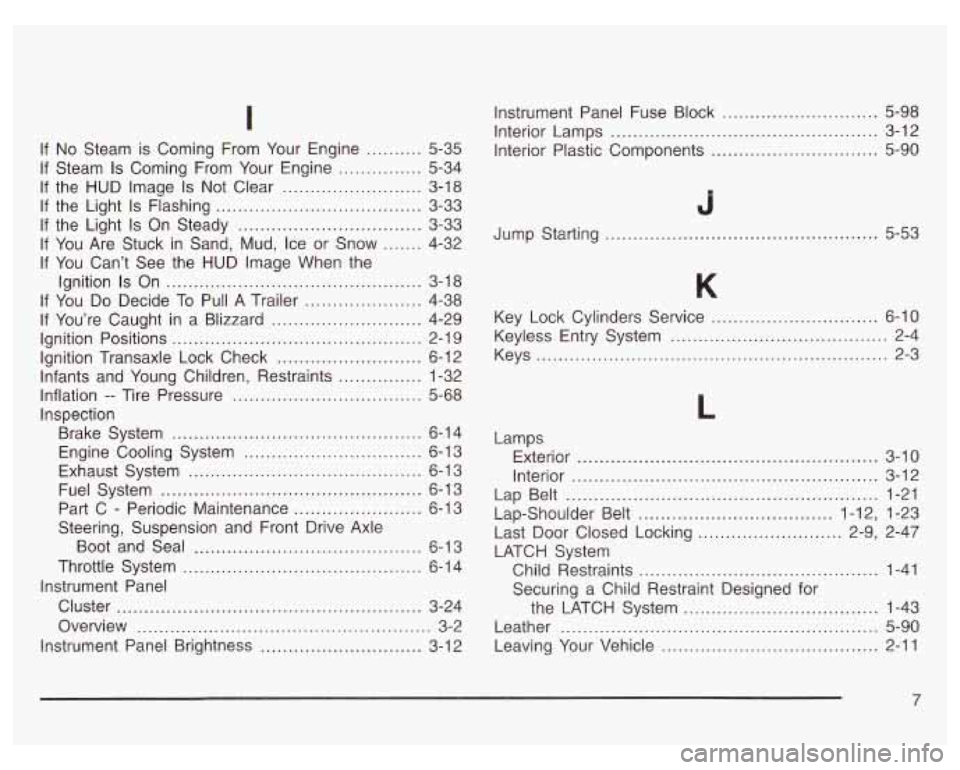2003 PONTIAC GRAND PRIX inflation pressure
[x] Cancel search: inflation pressurePage 216 of 378

Loading Your Vehicle
.
1 TIRE-LOADING INFORMATION
1 OCCUPANTS VEHiCLE 6
OT, ADD 28KPA(4PSI)
FOR MORE INFORMATION
Two labels on your vehicle show how much weight it
may properly carry. The Tire-Loading Information label is
on the inside of the trunk lid. The label tells you the
proper size, speed rating and recommended inflation
pressures for the tires on your vehicle. It also give you
important information about the number of people
that can be in your vehicle and the total weight you can
carry. This weight is called the vehicle capacity
weight and includes the weigh of all occupants, cargo
and all non-factory installed options. The
other label is the Certification label, found on the
rear edge of the driver’s door. It tells you the gross
weight capacity of your vehicle, called the Gross Vehicle
Weight Rating (GVWR). The GVWR includes the
weight of the vehicle, all occupants, fuel and cargo.
Never exceed the GVWR for your vehicle or the Gross
Axle Weight Rating (GAWR) for either the front or
rear axle.
4-35
Page 226 of 378

Section 5 Service and Appearance Care
Service ............................................................ 5.3
Doing Your
Owr? Service Work ......................... 5-4
Adding Equipment to the Outside of
Your Vehicle
.............................................. 5-4
Fuel ................................................................ 5-5
Gasoline Octane
............................................ 5-5
Gasoline Specifications
.................................... 5-5
California Fuel
............................................... 5-6
Additives
....................................................... 5-6
Fuels in Foreign Countries
............................... 5-7
Filling Your Tank
............................................ 5-7
Filling a Portable Fuel Container
....................... 5-9
Checking Things Under the Hood .................... 5-10
Hood Release
.............................................. 5-10
Engine Compartment Overview
....................... 5-12
Engine Oil
................................................... 5-18
Supercharger Oil
.......................................... 5-24
Engine Air CleanedFilter
................................ 5-25
Automatic Transaxle Fluid
.............................. 5-27
Engine Coolant
............................................. 5-30
Radiator Pressure Cap
.................................. 5-33
Cooling System
........................................... -5-36
Power Steering Fluid
..................................... 5-46
Windshield Washer Fluid
................................ 5-48
Engine Overheating
....................................... 5-33 Brakes
........................................................ 5.49
Battery
........................................................ 5.52
Jump Starting
............................................... 5-53
Bulb Replacement .......................................... 5-60
Halogen Bulbs
.............................................. 5-60
Headlamps
.................................................. 5-60
Front Turn Signal and Sidemarker Lamps
........ 5-62
Center High-Mounted Stoplamp (CHMSL)
......... 5-63
Taillamps, Sidemarker and Back-up Lamps
...... 5-64
Replacement Bulbs
....................................... 5-66
Windshield Wiper Blade Replacement .............. 5-67
Tires ............................................................. -5-68
Inflation
-- Tire Pressure ................................ 5-68
Tire Inspection and Rotation
........................... 5-69
When It
Is Time for New Tires ....................... 5-70
Buying New Tires
......................................... 5-71
Uniform Tire Quality Grading
.......................... 5-72
Wheel Replacement
...................................... 5-73
Headlamp Aiming ........................................... 5-59
Wheel Alignment and Tire Balance
.................. 5-73
Tire Chains
.................................................. 5-75
If a Tire Goes Flat ........................................ 5-76
Changing a Flat Tire
..................................... 5-76
Compact Spare Tire
...................................... 5-87
5- 1
Page 293 of 378

Tires
Your new vehicle comes with high-quality tires made by
a leading tire manufacturer.
If you ever have questions
about your tire warranty and where to obtain service,
see your Pontiac Warranty booklet for details.
. -orly mai __ and impropel used tires
are dangerous.
Overloading your tires can cause
overheating as a result of too much
friction. You could have an air-out and a serious accident. See “Loading Your
Vehicle” in the Index.
Underinflated tires pose the same danger
as overloaded tires. The resulting accident
could cause serious injury. Check all tires
frequently to maintain the recommended pressure. Tire pressure should be checked
when your tires are cold.
CAUTION: (Continued)
Overinflated tires are more likely to be
cut, punctured or broken by a sudden
impact
- such as when you hit a pothole.
Keep tires at the recommended pressure.
Worn, old tires can cause accidents. If
your tread
is badly worn, or if your tires
have been damaged, replace them.
Inflation -- Tire Pressure
The Tire-Loading Information label, which is on the
inside of the trunk lid, shows the correct inflation
pressures for your tires when they’re cold. “Cold” means
your vehicle has been sitting for at least three hours
or driven no more than
1 mile (1.6 km).
Notice: Don’t let anyone tell you that underinflation
or overinflation
is all right. It’s not. If your tires
don’t have enough air (underinflation), you can get
the following:
Too much flexing
Too much heat
Tire overloading
5-68
Page 294 of 378

Bad wear
0 Bad handling
Bad fuel economy
If your tires have too much air (overinflation),
you can get the following:
Unusual wear
Bad handling
Rough ride
Needless damage from road hazards
When to Check
Check your tires once a month or more.
Don’t forget your compact spare tire. It should be
at
60 psi (420 kPa).
How to Check
Use a good quality pocket-type gage to check tire
pressure. You can’t tell
if your tires are properly inflated
simply by looking at them. Radial tires may look
properly inflated even when they’re underinflated.
Be sure to put the valve caps back on the valve stems.
They help prevent leaks by keeping out dirt and
moisture.
Tire Inspection and Rotation
Tires should be rotated every 7,500 miles (1 2 500 km).
Any time you notice unusual wear, rotate your tires
as soon as possible and check wheel alignment.
Also
check for damaged tires or wheels. See When It Is Time
for New Tires on page
5-70 and Wheel Replacement
on page 5-73 for more information.
The purpose of regular rotation is to achieve more
uniform wear for all tires on the vehicle. The first rotation
is the most important. See “Part A: Scheduled
Maintenance Services,’’ in Section
6, for scheduled
rotation intervals.
1
When rotating your tires, always use the correct rotation
pattern shown here.
5-69
Page 295 of 378

Don’t include the compact spare tire in your tire rotation.
After the tires have been rotated, adjust the front and
rear inflation pressures as shown on the Tire-Loading
Information label. Make certain that all wheel nuts
are properly tightened. See “Wheel Nut Torque” under
Capacities and Snncifjcations
on page 5- 102.
Rust or dirt on a wheel, or on ,,le parts to
which it is fastened, can make wheel nuts
become loose after a time. The wheel could
come
off and cause an accident. When you
change a wheel, remove any rust or dirt from
places where the wheel attaches to the vehicle.
In an emergency, you can use a cloth or a
paper towel to do this; but be sure to use a
scraper or wire brush later, if you need to, to
get all the rust or
dirt off. See “Changing a Flat
Tire”
in the Index.
When It Is Time for New Tires
One way to tell when it’s
time for new tires is to
check the treadwear
indicators, which will
appear when your
tires have only
1/16 inch (1.6 mm)
or less of tread
remaining.
You need a new tire
if any of the following statements
are true:
You can see the indicators at three or more places
around the tire.
You can see cord or fabric showing through the
0 The tread or sidewall is cracked, cut or snagged
tire’s rubber.
deep enough to show cord or fabric.
5-70
Page 338 of 378

Part B: Owner Checks and Services
Listed in this part are owner checks and services
which should be performed at the intervals specified to
help ensure the safety, dependability and emission
control performance of your vehicle.
Be sure any necessary repairs are completed at once.
Whenever any fluids or lubricants are added to your
vehicle, make sure they are the proper ones, as
shown in Part D.
At Each Fuel Fill
It is important for you or a service station attendant to
perform these underhood checks at each fuel fill.
Engine Oil bevel Check
Check the engine oil level and add the proper oil if
necessary. See Engine Oil on page 5-18 for further
details.
Engine Coolant Level Check
Check the engine coolant level and add DEX-COOL@
coolant mixture
if necessary. See Engine Coolant
on page 5-30 for further details.
Windshield Washer Fluid Level Check
Check the windshield washer fluid level in the windshield
washer tank and add the proper fluid
if necessary.
See Windshield Washer Fluid on page 5-48 for
further details.
At Least Once a Month
Tire Inflation Check
Make sure tries are inflated to the correct pressures.
Don’t forget to check your spare tire. See Tires
on
page 5-68 for further details.
Cassette Tape Player Service
Clean cassette tape player. Cleaning should be done
every
50 hours of tape play. See Audio System(s)
on page 3-44 for further details.
6-9
Page 366 of 378

If No Steam is Coming From Your Engine .......... 5-35
If Steam
Is Coming From Your Engine ............... 5-34
If the HUD Image
Is Not Clear ......................... 3-18
If the Light
Is Flashing ..................................... 3-33
If the Light
Is On Steady ................................. 3-33
If You Are Stuck in Sand, Mud, Ice or Snow
....... 4-32
If You Can’t See the HUD Image When the
Ignition
Is On .............................................. 3-18
If You
Do Decide To Pull A Trailer ..................... 4-38
Ignition Positions
............................................. 2-1 9
Ignition Transaxle Lock Check
.......................... 6-12
Infants and Young Children, Restraints
............... 1-32
Inflation
-- Tire Pressure ............................... 5-68
Inspection Brake System
........................... ........... 6-14
Engine Cooling System
................................ 6-13
Exhaust System
.......................................... 6-13
Fuel System
............................................... 6-13
Part C
- Periodic Maintenance ....................... 6-13
Steering, Suspension and Front Drive Axle
Boot and Seal
......................................... 6-1 3
Throttle System
........................................... 6-14
Cluster
....................................................... 3-24
Overview
..................................................... 3-2
Instrument Panel Brightness
............................. 3-1 2
If
You’re Caught in a Blizzard
........................... 4-29
Instrument Panel Instrument Panel
Fuse Block
........................ 5-98
Interior Plastic Components .............................. 5-90
Interior
Lamps
................................................ 3-12
Jump Starting
................................................. 5-53
Key Lock Cylinders Service .............................. 6-10
Keyless Entry System
....................................... 2-4
Keys
............................................................... 2-3
L
Lamps Exterior
............................................... 3-10
Interior
....................................................... 3-12
Lap Belt
........................................................ 1-21
Lap-Shoulder Belt
................................... 1.12. 1-23
Last Door Closed Locking
.......................... 2.9. 2-47
LATCH System Child Restraints
........................................... 1-41
Securing a Child Restraint Designed for
the LATCH System
................................... 1-43
Leather
......................................................... 5-90
Leaving Your Vehicle
....................................... 2-11
7
Page 372 of 378

Steering ........................................................ 4-1 3
Steering in Emergencies
.................................. 4-14
Steering, Suspension and Front Drive Axle Boot
and Seal Inspection
..................................... 6-13
Steering
Tips .................................................. 4-13
Steering Wheel Controls, Audio
......................... 3-56
Storage Areas Center Console Storage Area
........................ 2-40
Convenience Net
......................................... 2-41
Glove Box
.................................................. 2-40
Overhead Console
....................................... 2-40
Purse or Litter Bag Holder
............................ 2-41
Rear Storage Area
....................................... 2-41
Trunk Access Panel
..................................... 2-41
Storing the Flat Tire and Tools
.......................... 5-85
Storing the Spare Tire and Tools
....................... 5-86
Stuck in Sand, Mud, Ice or Snow
...................... 4-32
Sun Visors
................................... ........... 2-14
Sunglasses Storage Compartment
.................. 2-40
Sunroof
......................................................... 2-42
Supplemental Restraint System
(SRS) ............... 1-51
How Does an Air Bag Restrain?
.................... 1-55
Servicing Your Air Bag-Equipped Vehicle
......... 1-57
What Makes an Air Bag Inflate?
.................... 1-55
What Will You See After an Air Bag
Inflates?
.................................................. 1-56
When Should an Air Bag Inflate?
................... 1-55
Where Are the Air Bags?
.............................. 1-53
T
Tachometer .................................................... 3-25
Taillamps Sidemarker
and Back-up Lamps .................... 5-64
TCS Warning Light
.......................................... 3-29
Temperature Display
................................ 2.34. 2-35
Theft.Deterrent. Radio
..................................... 3-54
Theft-Deterrent Systems
................................... 2-15
Content Theft-Deterrent
................................ 2-15
PASS-Key@
Ill ............................................. 2-16
Throttle System Inspection
............................... 6-14
Tilt Wheel
........................................................ 3-4
Tire Inflation Check
........................................... 6-9
Tires
..................................................... 5-68, 5-93
Buying New Tires
........................................ 5-71
Chains ....................................................... 5-75
Changing a Flat Tire
.................................... 5-76
Compact Spare Tire
..................................... 5-87
If a Tire Goes Flat
....................................... 5-76
Inflation
-- Tire Pressure ............................... 5-68
Inspection and Rotation
................................ 5-69
Uniform Tire Quality Grading
......................... 5-72
Wheel Alignment and Tire Balance
................. 5-73
Wheel Replacement
..................................... 5-73
When It
Is Time for New Tires ...................... 5-70
PASS-Key@
Ill Operation .............................. 2-17
13